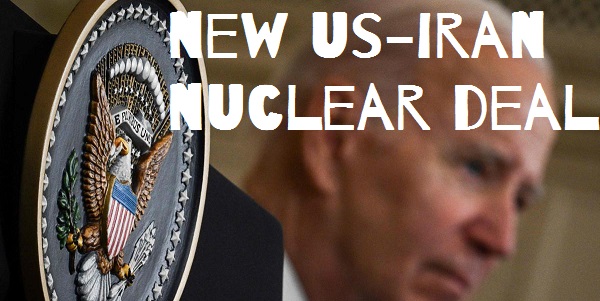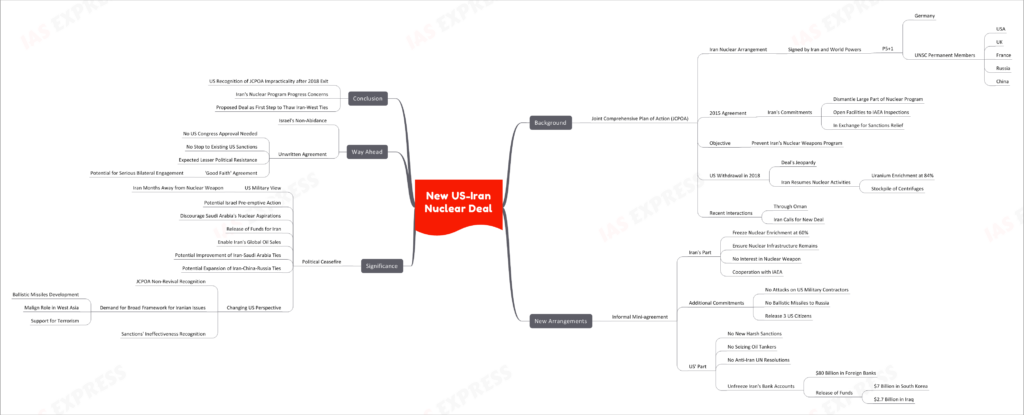New US-Iran Nuclear Deal- Background, New Arrangements & Significance

From Current Affairs Notes for UPSC » Editorials & In-depths » This topic
IAS EXPRESS Vs UPSC Prelims 2024: 85+ questions reflected
The US and Iran are reportedly working on a new nuclear deal, years after US’ exit from the 2015 JCPOA. Though the deal is more of a ‘good faith’ arrangement, it is expected to pave way for more sustainable bilateral negotiations between Iran and the global powers.

Background:
- The Joint Comprehensive Plan of Action (commonly called Iran Nuclear Arrangement) is an international accord signed between Iran on one side and several world powers (P5+1) on the other side- Germany and the P5 (permanent members) of UNSC (USA, UK, France, Russia and China).
- Under this 2015 agreement,
- Iran agreed to dismantle a large part of its nuclear program.
- It also agreed to open its nuclear facilities to extensive international inspections by the IAEA (International Atomic Energy Agency).
- In exchange, it would receive sanctions relief.
- This deal was concluded with the objective of preventing Iran from proceeding with its nuclear weapons program.
- However, USA withdrew from this landmark deal in 2018, putting the arrangement in jeopardy.
- Following this development, Iran has resumed some of its nuclear activities.
- Its uranium enrichment program has reached 84%.
- It has stockpiled thousands of centrifuges.
- In the recent months, Iran and USA have been interacting to thaw the ties, including a readiness for a fresh deal on the nuclear issue. Following interactions with the USA, through Oman, the Iranian leadership called for a new nuclear deal, as opposed to the revival of the earlier deal.
What do the new arrangements entail?
- The new deal is to be an informal and unwritten ‘mini-agreement’.
- For Iran’s part:
- Iran to freeze its nuclear enrichment at 60%.
- The new deal has to ensure that the country’s nuclear infrastructure remain in place.
- The country has no interest in nuclear weapon.
- The leadership is ready to cooperate with IAEA inspectors.
- Apart from this, the country will also:
- Not attack US military contractors in Iraq and Syria.
- Not supply ballistic missiles to Russia.
- Release the 3 US citizens under its custody.
- In return, US is to:
- Refrain from imposing new harsh sanctions on Iran.
- Not seize oil tankers in the Gulf waters.
- Not pursue anti-Iran resolutions at the UN.
- Un-freeze Iran’s bank accounts, accounting for some $80 billion, in different banks outside the country.
- Allow the release of:
- $7 billion in South Korea
- $2.7 billion in Iraq
What is the significance?
- The new deal is being perceived as a ‘political ceasefire’. According to the US military, Iran is just months away from building a nuclear weapon. This is a source of concern as it could push Israel to take pre-emptive military action, with/ without US support.
- Another significance of this deal is that it could discourage Saudi Arabia’s nuclear aspirations as well.
- The deal could release millions of dollars in the shorter term, for Iran, especially at a time when its population is facing dire living conditions.
- It will also enable Iran to sell its oil in the global market more freely.
- The deal could also be used to improve the Iran-Saudi Arabia ties. Iran could also use this to expand its political and economic ties with China and Russia.
- This new move is also significant given the changing perspective in the US:
- Recognition that the JCPOA cannot be revived in its original form.
- Demand for a broad framework to address several issues regarding Iran:
- Iranian development of ballistic missiles.
- Iran’s ‘malign’ role in West Asia.
- The country’s support for terrorism.
- Recognition that sanctions are no longer effective in influencing the country’s responses to pressures from the US.
What is the way ahead?
- Israel isn’t expected to abide by the new deal’s conditions and Iran doesn’t expect long-term value from the deal either.
- Since this is to be an unwritten agreement, the US government will not have to seek approval from its Congress.
- Also, as it doesn’t entail a stop to the existing sanctions from the US government, the new deal is expected to face lesser political resistance.
- If this ‘good faith’ agreement holds, it could pave the way for more serious bilateral engagement on other matters of common concern.
Conclusion:
The US has long recognized the impracticality of reviving the JCPOA after the 2018-exit. With Iran’s reported progress with its nuclear program, there is a growing concerns over a region-wide conflagration. Hence, the proposed new deal, despite its informality, may prove to be a first step to thaw Iran’s ties with the West.
Practice Question for Mains:
How does the new Iranian nuclear deal differ from the 2015 JCPOA? Explain. (250 words)
If you like this post, please share your feedback in the comments section below so that we will upload more posts like this.

